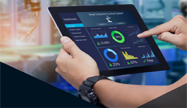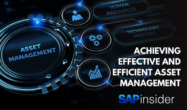SAP Asset Tracking
Filter By
Browse By
- SAP Analytics and AI
- SAP Application Development and Integration
- All SAP Application Development and Integration
- SAP ABAP
- SAP ABAP Development Tools
- SAP ABAP Test Cockpit
- SAP API Management
- SAP BAPI
- SAP Basis
- SAP BRF
- SAP Business Application Studio
- SAP CMS
- SAP Design Studio
- SAP Development Tools
- SAP DevOps
- SAP EAI
- SAP EDI
- SAP Extension Suite
- SAP Fiori
- SAP Fiori Elements
- SAP Integration Suite
- SAP Low Code Application Development
- SAP Low Code Automation
- SAP Netweaver
- SAP Release Management
- SAP UI5
- SAP Web Application Server
- SAP Web IDE
- SAP Business Process Management
- SAP Center of Excellence
- SAP CIO
- SAP Customer Experience
- SAP Data and Data Management
- All SAP Data and Data Management
- SAP BW
- SAP BW/4HANA
- SAP Crystal Reports
- SAP Data Archiving
- SAP Data Center
- SAP Data Governance
- SAP Data Integration
- SAP Data Migration
- SAP Data Quality
- SAP Data Services
- SAP Data Strategy
- SAP Data Visualization
- SAP Data Warehouse Cloud
- SAP DMS
- SAP Document Control
- SAP EIM
- SAP ETL
- SAP ETL Tools
- SAP HANA
- SAP HANA Administration
- SAP HANA Deployment Infrastructure
- SAP HANA Studio
- SAP Master Data
- SAP Master Data Governance
- SAP MDM
- SAP Enterprise Architect
- SAP Enterprise Asset Management
- SAP ERP
- SAP Finance
- All SAP Finance
- SAP Accounting
- SAP AR AP
- SAP Asset Accounting
- SAP Billing Systems
- SAP BPC
- SAP BRIM
- SAP Cash Management
- SAP Central Finance
- SAP Controlling
- SAP COPA
- SAP Cost Center Accounting
- SAP Currency Risk
- SAP e-invoicing
- SAP FICO
- SAP Finance Automation
- SAP Advanced Financial Closing
- SAP Financial Consolidation
- SAP Financial Planning
- SAP FX Risk
- SAP General Ledger
- SAP Global Tax Management
- SAP Hyperion
- SAP Order to Cash
- SAP Payment Processing
- SAP Profitability Analysis
- SAP Rebate Management
- SAP S/4HANA Finance
- SAP SWIFT Compliance
- SAP Treasury Management
- SAP Universal Journal
- SAP Governance Risk and Compliance
- SAP Human Capital Management
- SAP Intelligent Technologies
- SAP Platform and Technology
- All SAP Platform and Technology
- SAP Business Technology Platform
- SAP Cloud
- SAP Cloud Connector
- SAP Cloud Integration Platform
- SAP Cloud Migration
- SAP Cloud Platform
- SAP Cloud Providers
- SAP Cloud Strategy
- SAP Digital Signature
- SAP Container Platform
- SAP HANA Enterprise Cloud
- SAP Digital Asset Management
- SAP Smart Forms
- SAP HEC
- SAP Digital Integration Hub
- SAP Hyperscalers
- SAP Infrastructure
- SAP Messaging
- SAP Quality and Testing
- SAP Security
- SAP Spend Management
- SAP Supply Chain Management
- All SAP Supply Chain Management
- SAP APO
- SAP Asset Management
- SAP Business Network
- SAP Digital Manufacturing Cloud
- SAP Digital Twin
- SAP EWM
- SAP IBP
- SAP Inventory Management
- SAP Label Printing
- SAP Logistics
- SAP Manufacturing
- SAP Manufacturing Automation
- SAP MES
- SAP MII
- SAP MM
- SAP MRO
- SAP MRP
- SAP Order Management
- SAP Plant Maintenance
- SAP PLM
- SAP Production Planning
- SAP S&OP
- SAP SD
- SAP SPM
- SAP Supply Chain Planning
- SAP Track and Trace
- SAP Transportation Management
- SAP System Administration
Asset Tracking is the practice of understanding all the physical assets that a company has and tracking them. Examples of physical assets are generators, vehicles, computers, or other equipment. Most often this is done by a GPS tracking system, a bar code scanner or a RFID (radio-frequency identification device). Asset tracking is a good practice for all businesses, but it is becoming a necessity in some industries.
SAP asset tracking is part of Enterprise Asset Management with SAP Business Network for Asset Tracking. It is a centralized cloud-based hub using the Internet of Things (IoT) for an automated tracking solution. Asset performance is optimized by collecting, sharing, and tracking equipment usage information across a network, for collective asset management among business partners.
Key Capabilities of SAP Business Network for Asset Tracking include:
- Cloud based deployment: The cloud has minimal IT costs, low maintenance, and security management.
- Integration with SAP solutions: Ability to connect with other SAP solutions like SAP S/4HANA.
- Intuitive user experience. Simplifies the user experience by the SAP Fiori user experience.
- Collaborative partner relationships. Business partners have free basic membership to collaborate.
- Digital vehicle hub. Across the automotive and mobility value chain, you can enable new monetization streams.
Asset Tracking is the practice of understanding all the physical assets that a company has and tracking them. Examples of physical assets are generators, vehicles, computers, or other equipment. Most often this is done by a GPS tracking system, a bar code scanner or a RFID (radio-frequency identification device). Asset tracking is a good practice for all businesses, but it is becoming a necessity in some industries.
SAP asset tracking is part of Enterprise Asset Management with SAP Business Network for Asset Tracking. It is a centralized cloud-based hub using the Internet of Things (IoT) for an automated tracking solution. Asset performance is optimized by collecting, sharing, and tracking equipment usage information across a network, for collective asset management among business partners.
Key Capabilities of SAP Business Network for Asset Tracking include:
- Cloud based deployment: The cloud has minimal IT costs, low maintenance, and security management.
- Integration with SAP solutions: Ability to connect with other SAP solutions like SAP S/4HANA.
- Intuitive user experience. Simplifies the user experience by the SAP Fiori user experience.
- Collaborative partner relationships. Business partners have free basic membership to collaborate.
- Digital vehicle hub. Across the automotive and mobility value chain, you can enable new monetization streams.
By monitoring the condition of their assets, companies learn when an upgrade or replacement is needed to maintain productivity and have a competitive advantage. Asset tracking helps companies find better, more efficient ways of doing things. It integrates all the tracking into one interface, eliminating manual paperwork or spreadsheets.
Benefits of SAP Business Network for Asset Tracking are:
- Collaborative asset management. Enables the ability to share best practices of optimal management.
- Asset Management all in one place. A single repository for equipment information to enable effective management and customer service.
- Exchange asset performance feedback. Ability to connect with manufacturers, operators, or service providers to share performance analytics.
Vendors partners for asset management are: Movilitas, SAP, Precisely, Prospecta Software
Key Considerations for SAPinsiders:
- Capital Expenditure Management with SAP Fiori. Read the case study on how an integrated suite of SAP Fiori Apps can manage your capital expenditure from an annual budget through expenditure requests, projects, and asset capital management. The eBook shows common CAPEX challenges from companies and how SAP Fiori is a great platform for digitalization.
- Take Asset Management Planning to the Next Level. Read the article about how companies are realizing that asset management is not just about keeping up with assets. It is about balancing cost, risk, and performance to meet the company’s overall objectives. Discover how to bring advanced and strategic views of asset management to your organization.
- Connecting Manufacturing Products and Assets. This exclusive Q & A on loT disruption of the supply chain with SAP’s Thomas Ohnemus and Richard Howells, explains how loT can help businesses drive value from connected products, assets, and manufacturing. Discover key insights on how loT is transforming the world and how organizations should take part in this transformation.
840 results
-

 Premium
Premium
Capitalize Assets with Budget Monitoring Using Statistical Internal Orders
Reading time: 9 mins
See a method of direct capitalization with budgetary control that eliminates the need to post to the internal order and settle it. This method is best suited for simple budget monitoring of certain groups of assets — for example, lump sum budgets for furniture and fittings. Key Concept In an SAP system, assets are capitalized...…
-

 Premium
Premium
Learn How to Maintain Parallel Asset Values and Post to the SAP General Ledger
Reading time: 12 mins
Learn how to manage parallel values in SAP Asset Accounting using depreciation areas. Follow a discussion of parallel posting to the general ledger with the use of additional general ledger accounts. Key Concept SAP Asset Accounting (FI-AA) provides functionality to manage parallel asset values. In FI-AA, asset values are managed in parallel using a structure...…
-

SAP Intelligent Asset Management (SAP IAM)
Reading time: 3 mins
Enterprise Asset Management (EAM) is essential for asset-intensive organizations to optimize asset health and performance, and SAP’s Intelligent Asset Management (SAP IAM) suite provides a comprehensive solution for real-time monitoring, predictive maintenance, and collaborative asset intelligence to enhance decision-making and improve operational excellence across various industries.
-
-

 Premium
Premium
Take the Guesswork Out of Making Asset Changes
Reading time: 8 mins
When troubleshooting issues with fixed assets, you can use the simulation tool to simulate depreciation term changes and asset transactions to ensure your depreciation adjustments are correct. Key Concept When troubleshooting or diagnosing issues in SAP ERP, it is common to make changes to data or post new transactions to rectify a given problem, such...…
-

 Premium
Premium
Discover the Time-Dependent Depreciation Parameters of the New Depreciation Calculation in mySAP ERP 2005
Reading time: 36 mins
As of mySAP ERP 2005, SAP has delivered a new depreciation calculation in Asset Accounting. This algorithm introduces new depreciation concepts as well as new functionality — period interval-based parameters and time-dependent depreciation parameters. Key Concept The new depreciation calculation available with mySAP ERP 2005 is 100% compatible with the older one. No configuration changes...…
-

 Premium
Premium
Dealing with Ukraine Regulations? Understand How to Account for Fixed Asset Repairs
Reading time: 7 mins
Leverage the country-specific functionality of your SAP system for efficient accounting and compliance with local Ukrainian laws and regulations. Key Concept Fixed asset repair costs are usually charged off when they are incurred. However, Ukraine law has a distinctive requirement to capitalize such costs if they exceed a certain limit. An SAP system provides a...…
-

 Premium
Premium
Dodd-Frank Act: Standardize Risk Management Processes with SAP BusinessObjects Risk Management 10.0
Reading time: 17 mins
Ensure that your enterprise’s risk management procedures comply with the Dodd-Frank Act’s requirements pertaining to the management of systemic risks by using SAP BusinessObjects Risk Management 10.0. It supports the five phases of risk management. Key Concept The Dodd-Frank Act was signed into law in July 2010 in response to the 2007 US financial crisis....…
-
-

Transforming to Intelligent Asset Management with SAP Solutions
Reading time: 3 mins
Asset-intensive industries need to deliver on driving safe operations, minimizing costs, and maximizing productivity. But to consistently achieve these objectives, organizations must adopt a more comprehensive approach to Asset Management by enhancing collaboration with suppliers, customers, and service providers for better cooperation and coordination, streamlining asset maintenance processes, shifting from cyclical to predictive and intelligence-driven…
-

 Premium
Premium
How to Integrate FI-AA with the New G/L for Segment Reporting
Reading time: 8 mins
With the new general ledger (G/L), you no longer need custom programs or user exits to obtain the asset balances for segment reporting. Instead, you can update profit center/segments details for all asset transactions and depreciation postings in the new G/L. Find out what settings you need to make in Asset Accounting (FI-AA) to make...…
-

 Premium
Premium
11 Steps to a Successful Year-End Close for Fixed Assets
Reading time: 9 mins
Year-end closes often present problems both big and small. You can minimize these problems for both the current and subsequent year-end closes by following these simple steps. Key Concept The Fixed Asset module (Asset Accounting) is used to manage and supervise fixed assets within SAP R/3. It is a subsidiary ledger to the G/L, providing...…
Become a Member
Unlimited access to thousands of resources for SAP-specific expertise that can only be found here.
Become a Partner
Access exclusive SAP insights, expert marketing strategies, and high-value services including research reports, webinars, and buyers' guides, all designed to boost your campaign ROI by up to 50% within the SAP ecosystem.
Upcoming Events
Related Vendors
Your request has been successfully sent


